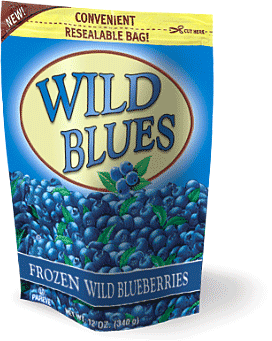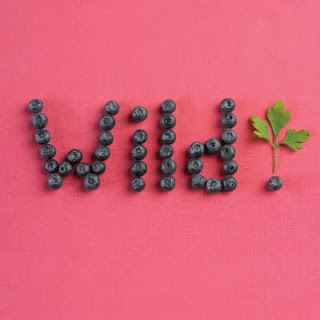Saving Your Frozen for Processing? You’re Missing Out

A recap of the 2011 Berry Health Benefits Symposium includes some interesting data about those small nutritional gems we know as berries. All varieties were under discussion this year at this California symposium, including strawberries, raspberries, blackberries, and blueberries, as participants piled on the evidence for the berry’s superfood status and the impact they have on health.
Berries seem destined to be in the spotlight. Research continues to uncover their powerful anti-aging properties and scientists continue to learn more about the important role they play in disease prevention, including skin cancer, colon cancer, brain health, and vision, even obesity. However, there is one point in this recap we take issue with:
“Unless you live in Maine, the fresh blueberries you eat are of the ‘high bush’ type. The ‘low bush’ or wild blueberries of the northeast (including Canada) are much smaller and have a very short season. They are mostly frozen and used in food processing.”
It’s true that the northeast shines when it comes to wild blueberries, and the point that wilds are only indeginous to the areas of Maine and Canada is well taken: it’s what makes this little blue berry so unique! However, this interesting fact requires some clarification. On behalf of frozen wild blueberry lovers across the nation, we felt compelled to make these two points to ripen the berry discussion:
 #1. Actually, they may have a short season, but the wild blueberries harvested in Maine and parts of Canada supply the entire country and parts of the world. Maine, for example, produces about 38% of the world’s wild blueberries and 15% of all blueberries in North America. Between Maine and Canada, around 204 million pounds of blueberries are harvested per year!
#1. Actually, they may have a short season, but the wild blueberries harvested in Maine and parts of Canada supply the entire country and parts of the world. Maine, for example, produces about 38% of the world’s wild blueberries and 15% of all blueberries in North America. Between Maine and Canada, around 204 million pounds of blueberries are harvested per year!
It’s becoming more and more common to live outside of Maine and still enjoy the benefits of wild — thank goodness, since the best way to get the most powerful dose of antioxidant benefit is to make sure you are buying wild, or lowbush berries.
Wild are smaller and have a higher skin-to-pulp ratio, and the skin is where the advantages reside. So while you may have trouble procuring a just-picked pint of wild blueberries outside of Maine or Canada, frozen wilds are available widely. You’ll find them in New England, in the South, in the West, even in California! Find out where to buy frozen wild blueberries.
#2. The idea that frozen is used primarily in food processing is simply short-sighted.
First, frozen is the best thing that has happened to nutrition since the icebox became the refrigerator. Frozen produce of all varieties provide a nutritious solution for families looking to make healthy eating more convenient and affordable.
What’s more: chefs love frozen wild blueberries and use them widely. Among our many interviews with chefs and cooks using frozen wild blues, the consensus is clear: they hold a sweet, complex flavor after baking because they are not as acidic as some fruits. They maintain their flavor nicely compared to other berries as well, and they stay truer to their original form. While some berries are processed, they are overwhelmingly used in recipes where they are not: wild blueberries can handle being mixed much more easily than a number of other fruits, and they are often used when the appearance of the whole fruit is important.
Second, frozen is as nutritious as fresh, and individual quick freezing (IQF) means berries are frozen at the peak of freshness in a way that preserves the whole berry: no blocks of ice, no cylinders of puree. Just all the wonders of wild blues. Yes, frozen is perfect for smoothies, but they are also perfect for most any purpose where fresh is used.
So, if you are saving your frozen wild blueberries for processing only, your missing out. Frozen wilds are much more versatile! Here are some of the many ways to take full advantage of their taste, texture, and nutrition, no processing involved:
In any recipe that calls for blueberries. That includes salsas and sauces, pies and cakes, crisps, grunts, crumbles and crème brulee.
As a topping. Wild blues add a colorful crown to many foods, no processing required. In fact, they are perfect for times when the appearance of the whole fruit in all its individual glory is needed. That includes yogurts, cereal, pancakes, and many uniquely delicious and colorful entrées, including fish, pork, and chicken.
On their own. Thaw (and strain a little, if you like) your frozen wild blueberries overnight, defrost in the microwave, or simply leave them on the counter briefly, and consume them with a fork, by hand as a snack, or scoop them out as a side for a sandwich or salad, au naturel. Each individual berry is beautiful preserved. And that blue on your fingertips is the stamp of rich nutrition—any time of year.
Berries from Coast to Coast
Kudos to California’s Berry Benefits Symposium for getting the word out about the wonders of berries. In Maine, the Bar Harbor Group dedicates itself to continuing nutritional research as it relates to berries as well. Each year, researchers and scientists from around the country gather to share ongoing research and findings about nature’s true nutritional jewels. In past years, presentations taking place at this famed summit have included research involving disease prevention and anti-aging, cancer, heart disease, Alzheimer’s and macular degeneration. We’ll keep you posted about this year’s summit, taking place during the summer.
Did you know? Frozen wild blueberries can remain ready to eat in the freezer year round, and the individually quick frozen method means they can remain frozen for over two years without losing their flavor or nutritional value. Love your frozen? Tell us why!

